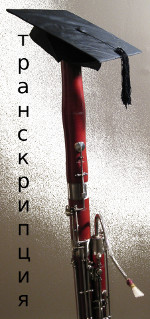Practicing Weissenborn Study #37
Weissenborn Opus 8/2, Study #37 for advanced bassoon students. Shaping
the phrase through tongued notes. My encounter with God, part B. By
Terry B. Ewell, Bassoon Digital Professor. Translated by Elena
Iakovleva. BDP#145. www.2reed.net.
Изучение этюда Nº37
Вайсенборн опус 8/2, этюд №37 для продвинутых студентов фаготистов.
Формирование фразы с артикулированими нотами. Моя встреча с Богом,
часть Б. Терри Б. Юэлл, Цифровый Профессор Фагота. Перевод, Елена
Яковлева. BDP # 145. www.2reed.net.
TUTORIAL Руководство
1. Welcome, this is Terry Ewell. This is the Weissenborn study famous for trills! My students usually dread playing this study. Perhaps for that reason, none of my students volunteered to perform this for the video series.
1. Добро пожаловать, это Терри Юэлл. Этот этюд Вайссенборна,
известен из за трелей! Мои ученики обычно боятся его играть. Возможно,
по этой причине никто из моих учеников не вызвался исполнить его для
этой видео-серии.
2. Let me provide a systematic practice method for trills that will help you master them. Trills have two components, the body and the nachschlag or termination. Nachshlag is the German term for the end portion of the trill.
2. Позвольте мне предоставить систематический метод занятия трелями, который поможет вам их освоить. Трели имеют два компонента: тело и nachschlag или окончание. Nachschlag - это немецкий термин для обозначения конечной части трели.
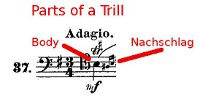
3. Notice that when an accidental is given above the trill, you need to add that accidental. For instance, the first trill is from B3 to C#4. The sharp over the trill indicates this.
3. Обратите внимание, что, когда над трелью написан случайный знак, вам нужно его добавить. Например, первая трель от Си 3 до До # 4. Диезный знак над трелью указывает на это.

4. Practice each component of the trill separately first. Focus on fluid finger movements and correct timing. Make certain to accurately meet the next beat. Let me practice now with a metronome. I will have eighth notes indicated with the metronome.
4. Поучите каждый компонент трели по отдельности. Сосредоточьтесь на плавных движениях пальцев и правильной синхронизации. Самое главное, точно войти на следующий удар. Послушайте как я играю с метрономом. Он будит бить восьмые ноты.

5. Next I practice the nachschlag. Notice that the nachschlag take place during one fourth of the note. Here is it written out:
5. Далее я учу nachschlag. Обратите внимание, что nachschlag длится одну четверть ноты. Вот это выписано:

6. Now I practice with the two put together. You might want to first practice by stopping the body of the trill on the middle of the beat and then playing the nachshlag.
6. Теперь я тренируюсь сыграть все вместе. Возможно, вы захотите сначала поучить трель, с остановкой в середине удара между телом трели u начшлагом.
7. Then you can practice the full trill with the nachschlag.
7. Затем вы можете сыграть полную трель с начшлагом.
8. Use this method practice for all of the trills in this
study.
Then go on to musically shape the trills. Vary your metronome setting
as appropriate. You will find that this practice method also helps with
the Mozart Bassoon Concerto and other bassoon repertoire.
9. Here are the fingerings for the trills in the first line.
9. Вот аппликатура для трелей в первой строчке.

10. In line 4 the C4 to D4 trill fingerings are the standard fingerings. The E4-F#4 has been given above. I use the alternate, left hand A4 fingering for the turn. Here are the fingerings for G4, A4, (G4 repeated), and F#4.
10. В 4й строке, играйте трель от Ми до Фа # 4 стандартной аппликатурой. Ми и Фа # 4 предоставлены повыше. Я использую альтернативную аппликатурy, в левой руке для Ля 4. Вот аппликатуры для Соль4, Ля4, (Соль 4 повторяется) и Фа # 4.

11. In this figure the red lines indicate the order of the fingerings moving from left to right. The blue lines show the position of the first and last fingerings for the turn.
11. На этом рисунке красные линии показывают порядок
перемещения пальцев слева направо. Синие линии показывают положение
первой и последней аппликатуры.
12. Here are the fingerings for the trills in lines 7 and 9.
12. Вот аппликатуры для трелей в 7й и 9й строчке.
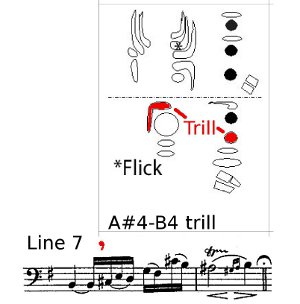
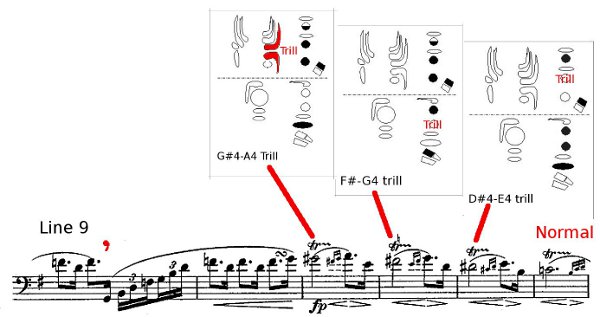
12a. I choose to lightly tongue the low B in line 2, measure 2
at
the fermata. I tongue the corner of the reed not directly in the
center. This still provides the sound of a slur but aids with the start
of the low note.
12a. Я выбираю слегка артикулировать низкий Си во 2м такте 2й строке, на фермата. Я трогаю языком угол трости, а не прямо в центре. Таким образом оно звучит легато, но низкая нота берется легче.
13. The rhythms in lines 8 and 9 are difficult. Practice carefully with a metronome to master the transitions between the 4 and 6 divisions of the beat.
13. Ритмы в 8й и 9й строки сложны. Тщательно позанимайтесь с метрономом, чтобы освоить переходы между делениями такта на 4 и на 6.

14. Line 10, measure 2 reminds me of getting on a merry-go-round as a child. Have you had that experience? When the merry-go-round is moving you need to run to get up to speed to hop on to it. In the same way you need to have the divisions of 6, the triplet 16ths going in your mind to “hop” on to the second beat.
14. 2й такт 10й строчки напоминает мне о том, как я в детстве поднимался на карусель. У вас был этот опыт? Когда карусель уже движется, вам нужно бежать, чтобы набрать скорость, и смочь на нее сесть. Точно так же вам нужно иметь деления на 6, шестнадцатые триоли, в уме, чтобы «запрыгнуть» на второй удар.
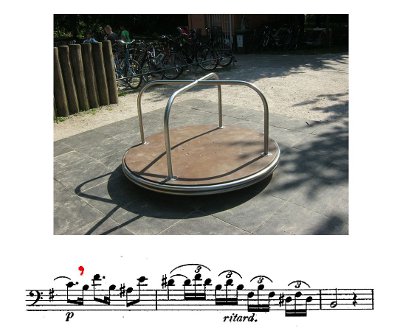
REFLECTION Размышление
15. This is a continuation of my reflection in Weissenborn
study
number 36.
A week or so after camp was over I went back to study piano lessons with Bela Siki. Before I had played more than about two or three phrases he stopped me and said, "Something has changed. Your touch is much more sensitive." I was too shy and embarrassed to explain the transformation that occurred in my life. In fact I was still trying to process just what was happening. It hadn't occurred to me that my musicality would be changed as well. Now I understand that God wants to touch and improve every aspect of my life. I began to realize that God was working in my inner self and anything that came out of it--thoughts, language, music, actions--would be impacted by those changes.
15. Это продолжение моего размышления в этюде Вайссенборна №
36.
Примерно через неделю после окончания музыкального лагеря я вернулся на
урок фортепиано с Bela Siki. Я сыграл двe или три фразы, и он остановил
меня и сказал: «Что-то изменилось. Ваше исполнения намного
более чувствительно». Я был слишком стеснительным и
смущенным, чтобы объяснить изменения, которое произошло в моей жизни.
На самом деле я все еще пытался понять, что было происходило. Мне не
приходило в голову, что моя музыкальность тоже могла изменится.
16. Clearly I can't say that I somehow earned that change in my life. I
wasn't devoted to a quest to find God and truth. It is more accurate to
say that God sought me rather than I sought God. I was just
going about living, trying to practice bassoon and piano,
doing my school work, surviving adolescence, etc. But now when I look
back on my life I realize that there were many times when I felt the
presence of God or the pull of His spirit. Over and over again God was
trying to get my attention and communicate with me.
16. Конечно, я не могу сказать, что я каким-то образом заработал это изменение в моей жизни. Я не был предан поиску Бога и истины. Точнее сказать, что Бог искал меня, а не я искал Бога. Я просто жил, пытаясь занимается на фаготе и пианино, выполняя свою школьную работу, выживая подростковый возраст и т. д. Но теперь, когда я оглядываюсь назад на свою жизнь, я понимаю, что было много раз, когда я чувствовал присутствие Бога или тягу Его духа. Много рас Бог пытался привлечь мое внимание и общаться со мной.
17. Please understand that I am not finished changing! The process that was begun on August 9th, 1973 was just the start. There is a lot of work yet to be done with me. I fail every day to live up to my full potential. However, I am also at peace knowing that God is working with me, in me, and through me.
17. Пожалуйста, поймите, что я еще не закончил изменяться!
Процесс, который начался 9го августа 1973 года, был только началом. У
меня еще много работы. Каждый день, я не полностью реализую свой
потенциал. Однако я также спокоен, зная, что Бог работает со мной, во
мне и через меня.
18. I suspect that if you are honest you will also acknowledge that you have felt the pull of God at times in your life. He has the peace, fulfillment, and happiness you have been searching for. I had a young friend who told me about Jesus and God. Let me be your friend and tell you as well.
18. Я подозреваю, что если вы честны, вы также признаете, что
время от времени вы ощущаете Божье притяжение. У него есть мир,
удовлетворение и счастье, которые вы искали. У меня был молодой друг,
который рассказал мне об Иисусе и о Боге. Позвольте мне быть вашем
другом и тоже вам рассказать.
19. For further information please see this website. God bless you.
19. Для дополнительной информации, пожалуйста, посетите этот
сайт. Будьте здоровы.
CREDITS
Merry-go-round picture.
Ein Spielplatzkarussell am Robinsonspielplatz Fasanengarten in Karlsruhe. 7 July 2013, Author: Zavijava2. http://en.wikipedia.org/wiki/File:Spielplatzkarussell_07072013.JPG (Accessed 20 April 2014)
